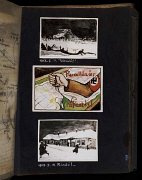|
|

|

|
This image shows Hungarian soldiers abandoning their trenches on the front lines as a Soviet tank overruns the barbed-wire fortification separating the two armies. Drawing dated January 11, 1943. [Photograph #58103] See more photographs |
BEIFELD ALBUM: COUNTEROFFENSIVE AND RETREAT |
||||
|
|
During the summer of 1942, the company was sent on long marches that took them close to the front line. Their duties included building fortifications, transporting ammunition, constructing bridges and roads, laying mines, burying the dead, and carrying away the wounded. As the summer progressed the heat intensified, their rations were cut back, and their treatment deteriorated. The company was repeatedly the target of raids by the military police, who confiscated their meager personal belongings, including soap and cigarettes, which left them with nothing to barter for extra food. The conscripts hung on in the hopes of being demobilized at the end of the summer. Instead, they were sent back to the front line in September. In the course of their work many labor servicemen, including Beifeld, suffered shrapnel wounds. When his wound became seriously infected Beifeld was sent to a field hospital in Plotawa, 15-20 km behind the front line. There, he became friendly with the chief physician, Dr. Bela Balta. |
|
The entire medical staff in the field hospital treated Beifeld with extraordinary care and respect and allowed him to remain for the full term of his convalescence. As soon as his hand began to improve, Beifeld started to draw and paint pictures of the hospital and its staff. Subsequently, he was entrusted with preparing the architectural drawings for a new field hospital. To forestall being sent back to his unit, Beifeld tried to make himself indispensable by taking up additional duties such as answering the phone, typing, and helping to transport the wounded. In his spare time, Beifeld wrote about the tough conditions faced by his labor battalion comrades during the Russian winter. Nearly half of his company's original 200 conscripts had either perished or were taken out of action with frostbite, malnutrition, and other ailments. |
 |
||
|
See more artifacts Album page |
|
Examine pages from the album by clicking on See artifacts and using the zoom tool to select and magnify areas of the image. |
|
On January 13, 1943, the new commander of the Soviet Army of the Don, General Georgi Zhukov, began a surprise counteroffensive that resulted in the destruction of the majority of the Second Hungarian Army and the retreat of the remainder to Kiev. Beifeld wrote pages of detailed and graphic descriptions of the chaotic evacuation in the snow under the bombardment of Russian planes. In one poignant description, he writes: We started our Napoleonic-style retreat [which lasted from January 13 to March 6] in snow that was 70 centimeters deep, in temperatures that reached minus 46 degrees centigrade…Running night after night in deep snow…Stumbling, sneaking, sliding, holding on to the sled with both hands until they became stiff…This is how one imagines a typical picture of retreat. Cars, horse-drawn wagons carrying ammunition, tanks, small engines pulling cannons, yokes of oxen, Russian sleds, total confusion… The wind was blowing icicles into our eyes. Our breath got frozen to the fabric we used to cover our faces. One's legs were in great pain dragging the body…Anyone who got exhausted and sat down for a minute would inevitably freeze to death. That applied equally to men and horses. They lay there next to each other frozen to death, a soldier, a horse, and a Jew. Despite all their suffering heretofore, the worst period for the Jewish conscripts in the Hungarian labor service came after their arrival in Kiev. There, they met up with the regular forces of the Hungarian army of occupation in the Ukraine, who ruthlessly persecuted them in their attempt to replenish their supply of war booty, which they had lost during the retreat. Beifeld managed to remain under the protection of Dr. Balta until the first week in April, when he was sent towards the Jewish reception camps dressed in a Hungarian military uniform with well-stocked bread bags and a laissez passer. He narrowly escaped capture by the military police, and looting and beatings at a collection center for Jewish conscripts in Pogoreloye. Eventually Beifeld met up with the remnants of his original company in a village called Vidinye. From here, he and his comrades were taken to another camp, where there was almost no food or water and where they were greeted with blows from the guards. Beifeld managed to maintain his health thanks to the assistance of a Hungarian first lieutenant, who gave him food every day in exchange for a couple of watercolors. This situation lasted for about three weeks, until May 23, when a Hungarian general, after visiting the labor service personnel, ordered their evacuation. Within days the survivors, including Beifeld, were sent home by train. Knowing that his pictures had saved his life, Beifeld refused to abandon his artistic oeuvre during the long retreat, even though his comrades jettisoned or bartered everything they had in order to survive. Read more about Beifeld's visual memoir and explore pages from sections of the album: introduction; humor in the Beifeld album; in the labor service; assembling the album. |
|
|
|